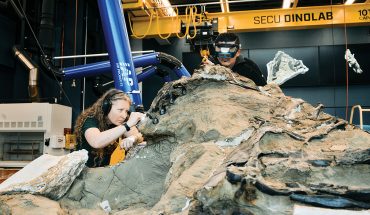The History of Raleigh Rose Garden
by Shelley Crisp
Each year, thousands of flowers bloom from early spring through late fall in the historic Raleigh Rose Garden on Pogue Street. Centered in Raleigh Little Theatre’s 6.6-acre campus, the Rose Garden sits a few blocks from Cameron Village in one direction and N.C. State University in another. This city park might feel like a delightfully lush surprise in downtown Raleigh, but it was once on the farthest outskirts of town. In fact, the garden’s history dates back to the late 19th century when, before there were roses, there were horses and racetracks, followed by an army camp and tanks.
The history of this Raleigh Historic District dates to the early 1870s, when Sallie E. Brown and Timothy Lee sold parcels of land around Hillsborough Street, Horne Street, and Brooks Avenue to the North Carolina State Agricultural Society for a fairground to be relocated from east of the Capitol. Between 1873 and 1925, the N.C. State Fair occupied much of the area between the present-day Raleigh Little Theatre and then-called State College, which formed a natural border.
During the years of World War I, the site was the temporary location for Camp Polk, the only tank camp in America, where the hilly topography proved perfect for tank maneuvers.
By 1920, the State Fair was back, including numerous structures – namely, not one, but two racetracks. The addition of the second track, at the suggestion of Edith Stuyvesant Vanderbilt of Asheville, then president of the N.C.
Agricultural Society, was a notably unsustainable decision: Unable to pay off the mortgage assumed to pay for the track, the Society was forced to sell the property. It was divided up and sold as one of Raleigh’s then-new trolley-car suburbs, Fairmont. Eventually, the City of Raleigh bought the unsold lots, including what former Raleigh mayor George Iseley described in the ’30s as “a very large hole in the ground, the old racetrack, an eyesore to the citizens and a problem to the commissioners.” For years, it remained undeveloped in the center of the up-and-coming suburbs, earning a reputation as the unbuildable plot of earth called the “Fairmont Bowl.”
Sutton’s soul
In 1939, the city broke ground on an amphitheater and theater building with a landscape plan that included an arboretum to accommodate the Fairmont Bowl. Legend has it that Cantey Venable Sutton, a civic leader who spearheaded the construction of the Raleigh Little Theatre campus, had long had a rose garden in mind for the plot. In fact, however, rose beds were not part of the original plan.
After Raleigh Little Theatre’s first performance in the outdoor amphitheater in June 1939, the City of Raleigh hired landscaper Arnold Peterson to supervise plantings at both buildings. The unbuildable plot became optimistically referenced in those early plans as the “sunken gardens,” but there were still no intended rose beds.
For the buildings’ landscaping, Sutton requested the donations of bulbs, plants, shrubs, and trees from garden clubs and individuals across the state. “When we get through,” said Sutton in the ’40s, “we expect to have a place of which every citizen of North Carolina will be proud.” She enlisted one of North Carolina’s most celebrated gardeners, Elizabeth Lawrence of Raleigh, to supervise the plantings around the main theater.
Drought killed most of the original plantings, so the Raleigh Parks and Recreation Commission considered converting the property into tennis courts. But Sutton would not let the gardens go, nor the notion of roses. She headed a formal Rose Garden Committee and successfully campaigned the Raleigh City Council to budget funds for establishing and maintaining the garden. In 1947, landscape architect R.J. Pearse mapped out a 250-by-132-foot area for, at last, rose beds. Amos Fowler of Fowler’s Nursery planted the first rose in 1948.
Between 1948 and 1950, Raleigh Parks Department gardeners planted 3,000 rose bushes with various shrubs and trees, constructed a memorial fountain and trellises, and planted azaleas from Wilmington and memorial poplars from George Watts Hill in Durham. Sutton donated the purchase of a fountain and a statue of a boy riding a swan, both designed by J. Morely Williams of New Bern. The fountain was dedicated to Sutton’s parents, former UNC president Dr. Francis P. Venable and Sally Venable.
During the first year, water was trucked in by barrels and distributed by hand, as there was no irrigation system. But it was a start, and what had been an “unsightly clay pit that was a tangle of red mud and weeds,” according to a 1939 News & Observer article, became one of the country’s showcase rose gardens with over 60 formal beds of roses, including floribunda, grandiflora, hybrid tea, miniature, shrub, and climbing roses.
The Raleigh Rose Garden, from its very beginning the embodiment of community collaboration and pride, was dedicated and handed off to the City of Raleigh in May 1951. At the dedication ceremony, according to local newspaper articles, Sutton presented a “rose-embellished map of the garden” to then-Raleigh mayor P.D. Snipes. “I put my soul and being behind the project,” Sutton said. But Sutton would also be the first to emphasize that the garden began and succeeded because of the efforts of many hands, including the Raleigh Rose Society, the Raleigh Garden Club, the Raleigh Women’s Club, the Men’s Horticultural Club, and the City of Raleigh.
The garden today
Since 1951, the Rose Garden has continued to bloom. In 1952, John Coffey & Son Builders built the ashlar stone and gable-roofed shelter for less than $2,000. In 1955, the city hired Rosarian Edward Anderson from London, a graduate of the Royal Horticultural Society School and head of the Royal Botanic Garden in Edinburgh, to supervise the garden, assisted by Roosevelt Elliott. In 1957, Edwin G. Thurlow, founder of the N.C. State School of Design Landscape Architecture program, drew plans for the areas surrounding the formal rose beds. In 1990, the garden, as part of the RLT campus, was nominated for Raleigh Historic Property Designation status.
For many years, the garden was a display destination for the All-American Rose Selection annual winner, and many select varieties still thrive in the garden. Until 2006, there had been a few original roses planted from Sutton’s day, most prominently the silver moon climbing rose. There are no longer any of the original varieties. Where there were once show girl, farmer’s daughter, crimson glory, jiminy cricket, and nocturne, there are now brigadoon, marmalade skies, Elizabeth Taylor, Reba McEntire, first kiss, glowing peace, starry night, and fragrant cloud.
The Rose Garden today still embodies the spirit of community collaboration and pride of its origins. The plot thrives from the stewardship and care of the City of Raleigh Parks, Recreation, and Cultural Resources department and a legion of dedicated volunteers known as the Dead-Headers. Roses bloom from May until fall’s first frost in October or November, and rose-viewing is in its prime around Mother’s Day.
As the city around it has evolved, so has the garden: There are still outdoor dramas, and now, too, festivals, family celebrations, movies, weddings, concerts, yoga classes, once even a Pokémon Go gym. Cantey Sutton, the garden’s early and tireless champion, would be proud to know that her 1940s hope to create a place of pride has indeed become a city legacy of beauty, artistry, and, yes, civic pride.
To download three comprehensive maps and plant lists for the roses, the trees, and the perennials at the Rose Garden: raleighlittletheatre.org
Shelley Crisp is the former executive director of the North Carolina Humanities Council and past president of the Raleigh Little Theatre board of directors.






